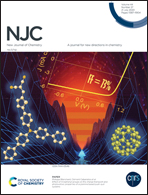Bonding between electron-deficient atoms: strong Lewis-acid character preserved in X–Y–X (X = B, Al; Y = Be, Mg) bridges†
Abstract
The structure, stability and bonding of beryllium bis(diazaborolyl) derivatives and their Mg and Al-containing analogues have been investigated through the use of G4-high level ab initio methods. This survey allowed us to conclude that not only the Be/B compounds, recently reported in the literature, but also their analogues in which Be is replaced by Mg and B is replaced by Al should exhibit similar bonding characteristics and stability and therefore should be, in principle, also experimentally accessible. In general, in all these derivatives B and Al, in spite of being intrinsically electron-deficient systems, behave as nucleophiles towards Be and Mg. One of the consequences of having two electron-deficient atoms involved in a bond is that the net charge associated to both of them is usually positive, in contrast with typical Be or Mg containing compounds, such as BeF2 or MgF2. However, this apparent dissimilarity is not so, because of the role of the second neighbors. Indeed, in the systems investigated, even though the Be–B, Be–Al, Mg–B or Mg–Al bonds are not too polar as compared with Be–F or Mg–F, the cluster can be viewed as the interaction between a positively charged Be(Mg) atom with two negatively charged ligands. Consistently, the homolytic dissociation enthalpies of the Be–ligand bonds, though smaller than that of the Be–F one, are still significantly large. Also importantly, the Lewis acid character of Be is still preserved, as all the Be compounds investigated lead to rather strong beryllium bonds when interacting with one or two typical Lewis bases, such as methylamine. The same behavior is observed for the corresponding Mg-containing analogues.



 Please wait while we load your content...
Please wait while we load your content...